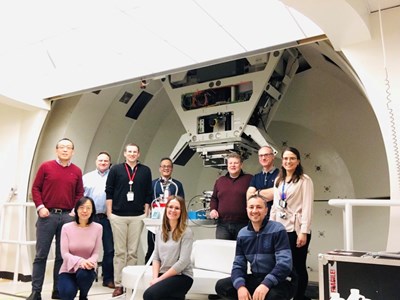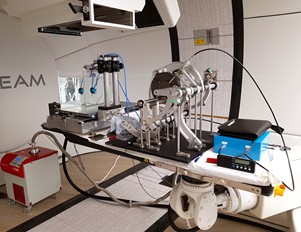More accurate radiotherapy to transform cancer treatment
30/08/2023
CANCER treatment could be transformed following a breakthrough in the development of a new and highly accurate radiotherapy treatment.

Scientists at the National Physical Laboratory (NPL), led by IPEM Fellow Russell Thomas, Science Area Leader of Medical Radiation Science, have worked on a range of projects that are set to significantly improve the accuracy of proton beam therapy (PBT).
They are also working with IPEM to develop a new Code of Practice (CoP) for reference dosimetry of proton beams.
PBT is seen as a superior option to established forms of radiotherapy because the radiation can be confined largely to the tumour, minimising the damage to surrounding healthy tissue. To make the most of the treatment, however, the accuracy of the radiation dose from proton beam treatment must be similar to that achieved using existing radiotherapy treatments.
To achieve this aim, the team at NPL have made three important breakthroughs:
- Producing their own highly accurate tool for measurement and assuring radiation dosage amounts called the Primary Standard Proton Calorimeter (PSPC)
- Developing new tissue-equivalent plastic materials to precisely imitate human tissue such as bone and muscle at the test phase
- Performing pioneering measurements to demonstrate a new form of radiotherapy called FLASH.
Accurately measuring PBT’s absorbed radiation dose
To maximise the accuracy and consistency of radiation dose measurement in PBT, the NPL developed the Primary Standard Proton Calorimeter (PSPC) to directly measure the absorbed radiation dose in proton radiotherapy beams.
Radiation dose measurement always comes with a level of uncertainty, but NPL’s PSPC reduces this uncertainty by more than half (0.9 percent instead of 2.3 percent) as reported by the international Code of Practice for radiotherapy dosimetry (TRS-398), making it more accurate than current international protocols.
With the PSPC, NPL ensures cancer patients undergoing PBT receive consistent and accurate radiation doses across different treatment facilities. This improves the chances of successfully treating the tumour and reduces variability in dose delivery to patients.
As the number of PBT treatment centres in the UK and elsewhere grows, it becomes increasingly important to have consistent and accurate dose delivery between them all. NPL's PSPC is a critical tool in achieving this goal, ensuring that cancer patients receive the best possible treatment.
New test materials precisely mimic human tissue
The NPL team has also developed pioneering new plastic materials that mimic the radiation properties of human bone and muscle tissue for photon imaging and proton beam treatments, as reported in Physics in Medicine & Biology, IPEM’s international peer-reviewed journal.
Existing test materials produce large uncertainties in proton therapy dosimetry resulting in relative differences in “range” of up to eight percent. As such, these existing materials cannot be used to provide accurate quality assurance measurements for proton therapy dosimetry.
In contrast, the new materials developed by NPL closely mimic the properties of human tissue in a proton beam within a one-to-two percent accuracy: this makes them much more effective when used to support radiation dosimetry measurements for complex proton treatment plans and clinical trials.
The novel tissue mimicking materials have been used to develop a device which mimics a head and neck patient for radiotherapy purposes. The plastic device is useful as it enables clinical centres to check and test the delivery of their proton therapy treatment without the need of a real patient.
The device has internal detectors which enable the user to take dose measurements which can be compared to predicted values from treatment planning software. These tests provide clinical centres with confidence in the delivery of their proton therapy treatments to patients.
Identifying the ideal dose for new ultra-high dose FLASH radiotherapy technique

Using pioneering measurement technology, NPL scientists measured and standardised the ideal optimal absorbed dose for a potentially revolutionary form of PBT known as FLASH.
The new FLASH radiotherapy (RT) treatment is as effective as current techniques but also prevents unnecessary damage to healthy tissue and considerably shorten the time that paediatric patients must spend in the hospital.
FLASH treatments can be delivered in fewer or even single deliveries in comparison to conventional radiotherapy, which is often delivered in fractions over a period of about six weeks with the patient having to attend hospital on a daily basis.
Accurate dosimetry is essential to avoid errors that might result in a patient receiving an incorrect dose of radiation and less chance of successful treatment. Currently, any form of radiotherapy results in unwanted but unavoidable deposition of radiation to healthy tissue around the targeted tumour. Studies have shown that treatment using ultra-high dose rate (UHDR) radiation could significantly spare healthy tissue while also being at least as effective as treatments at conventional dose rates in controlling the tumour – this is known as “the FLASH effect”.
The NPL breakthrough led to the first in-human clinical trial of FLASH RT in November 2020, which involved 10 patients at Cincinnati Children’s Hospital’s Proton Therapy Centre in Ohio, USA. The findings of the NPL team’s research were published in scientific journal Nature Scientific Reports in February (‘Absolute dosimetry for FLASH proton pencil beam scanning radiotherapy’).
Ana Lourenço, Principal Scientist at NPL, said: ‘We are working with IPEM to develop a new Code of Practice (CoP) for reference dosimetry of proton beams. The upcoming IPEM CoP will utilise the NPL PSPC and provide a direct absorbed dose to water calibration service for proton therapy beams. This significant development will reduce uncertainty in dose delivery, ensuring optimal tumour control and improved accuracy in proton therapy treatments.
‘The establishment of consistent standards supported by the CoP will not only benefit patients within and between treatment facilities but also lay the foundation for the development of clinical trials in proton therapy.’
Improving outcomes for cancer patients
Mr Thomas added: ‘Our team at NPL are widely recognised as world leaders in areas of proton dosimetry. For a number of years we have worked to develop a deeper understanding of fundamental aspects of dosimetry for this type of beam which has culminated in us developing dedicated primary standard specifically for proton radiotherapy.
‘Building on this, we are able to further refine the understanding of the response of ionisation chambers used in the clinic. Combined with that, my team have developed protocols for auditing clinics, a vital aspect in ensuring patient treatments are optimally delivered and have developed our own materials specifically to mimic the response of tissue, bone etc in the proton beam.
‘It is a privilege for me to lead such a dedicated and talented team of scientists whose work has a real impact in helping to improve outcomes and the quality of life of cancer patients.’